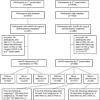A longitudinal study of risk factors for incident albuminuria in diabetic American Indians: the Strong Heart Study
- PMID: 18295057
- PMCID: PMC2776644
- DOI: 10.1053/j.ajkd.2007.11.010
A longitudinal study of risk factors for incident albuminuria in diabetic American Indians: the Strong Heart Study
Abstract
Background: There have been no studies that use longitudinal data with more than 2 measurements and methods of longitudinal data analysis to identify risk factors for incident albuminuria over time more effectively.
Study design: Longitudinal study.
Settings & participants: A subgroup of participants in the Strong Heart Study, a population-based sample of American Indians, in central Arizona, Oklahoma, and North and South Dakota. Participants with diabetes without albuminuria were followed up for a mean of 4 years.
Predictors: Age, sex, study center, high-density lipoprotein and low-density lipoprotein cholesterol levels, triglyceride level, body mass index, systolic blood pressure, use of antihypertensive medication, smoking, hemoglobin A(1c) level, fasting glucose level, type of diabetes therapy, diabetes duration, plasma creatinine level, and urinary albumin-creatinine ratio (UACR).
Outcomes & measurements: Albuminuria was defined as UACR of 30 mg/g or greater. Urine creatinine and albumin were measured by using the picric acid method and a sensitive nephelometric technique, respectively.
Results: Of 750 and 568 participants with diabetes without albuminuria and with normal plasma creatinine levels at the first and second examinations, 246 and 132 developed albuminuria by the second and third examinations, respectively. Incident albuminuria was predicted by baseline UACR, fasting glucose level, systolic blood pressure, plasma creatinine level, study center, current smoking, and use of angiotensin-converting enzyme inhibitors and antidiabetic medications. UACR of 10 to 30 mg/g increased the odds of developing albuminuria 2.7-fold compared with UACR less than 5 mg/g.
Limitations: Single random morning urine specimen.
Conclusions: Many risk factors identified for incident albuminuria can be modified. Control of blood pressure and glucose level, smoking cessation, and use of angiotensin-converting enzyme inhibitors may reduce the incidence of albuminuria.
Figures

Similar articles
-
Plasma lipoproteins and the incidence of abnormal excretion of albumin in diabetic American Indians: the Strong Heart Study.Diabetologia. 1998 Sep;41(9):1002-9. doi: 10.1007/s001250051023. Diabetologia. 1998. PMID: 9754817
-
Comparison of serum cystatin C, serum creatinine, measured GFR, and estimated GFR to assess the risk of kidney failure in American Indians with diabetic nephropathy.Am J Kidney Dis. 2013 Jul;62(1):33-41. doi: 10.1053/j.ajkd.2012.11.044. Epub 2013 Jan 21. Am J Kidney Dis. 2013. PMID: 23347458 Free PMC article.
-
Coronary heart disease prevalence and its relation to risk factors in American Indians. The Strong Heart Study.Am J Epidemiol. 1995 Aug 1;142(3):254-68. doi: 10.1093/oxfordjournals.aje.a117632. Am J Epidemiol. 1995. PMID: 7631630
-
Diet Quality and Kidney Outcomes in Adolescent and Adult American Indians: the Strong Heart Family Study.J Racial Ethn Health Disparities. 2024 Oct;11(5):2720-2728. doi: 10.1007/s40615-023-01735-x. Epub 2023 Aug 1. J Racial Ethn Health Disparities. 2024. PMID: 37526878
-
Urine Albumin-Creatinine Ratio Variability in People With Type 2 Diabetes: Clinical and Research Implications.Am J Kidney Dis. 2024 Jul;84(1):8-17.e1. doi: 10.1053/j.ajkd.2023.12.018. Epub 2024 Mar 15. Am J Kidney Dis. 2024. PMID: 38551531
Cited by
-
Insulin resistance, incident cardiovascular diseases, and decreased kidney function among nondiabetic American Indians: the Strong Heart Study.Diabetes Care. 2013 Oct;36(10):3195-200. doi: 10.2337/dc12-2368. Epub 2013 Jun 4. Diabetes Care. 2013. PMID: 23735722 Free PMC article.
-
Association between fish consumption and nephropathy in American Indians--the Strong Heart Study.J Ren Nutr. 2012 Mar;22(2):221-227. doi: 10.1053/j.jrn.2011.03.003. Epub 2011 Jul 13. J Ren Nutr. 2012. PMID: 21742515 Free PMC article.
-
Establishment and validation of the cut-off values of estimated glomerular filtration rate and urinary albumin-to-creatinine ratio for diabetic kidney disease: A multi-center, prospective cohort study.Front Endocrinol (Lausanne). 2022 Dec 12;13:1064665. doi: 10.3389/fendo.2022.1064665. eCollection 2022. Front Endocrinol (Lausanne). 2022. PMID: 36578951 Free PMC article.
-
Sex difference in the incidence of microvascular complications in patients with type 2 diabetes mellitus: a prospective cohort study.Acta Diabetol. 2020 Jun;57(6):725-732. doi: 10.1007/s00592-020-01489-6. Epub 2020 Feb 5. Acta Diabetol. 2020. PMID: 32025877 Free PMC article.
-
Albuminuria among Alaska Natives--findings from the Genetics of Coronary Artery Disease in Alaska Natives (GOCADAN) study.Nephron Clin Pract. 2010;115(2):c107-13. doi: 10.1159/000312873. Epub 2010 Apr 21. Nephron Clin Pract. 2010. PMID: 20407273 Free PMC article.
References
-
- Mogensen CE. Microalbuminuria predicts clinical proteinuria and early mortality in maturity-onset diabetes. New Engl J Med. 1984;310:356–360. - PubMed
-
- Arun CS, Stoddart J, Mackin P, MacLeod JM, New JP, Marshall SM. Significance of microalbuminuria in long-duration type 1 diabetes. Diabetes Care. 2003;26:2144–2149. - PubMed
-
- Dinneen SF, Gerstein HC. The association of microalbuminuria and mortality in non-insulin-dependent diabetes mellitus. A systematic overview of the literature. Arch intern Med. 1997;157:1413–1418. - PubMed
-
- Niskanen LK, Penttila I, Parviainen M, Uusitupa MI. Evolution, risk factors, and prognostic implications of albuminuria in NIDDM. Diabetes Care. 1996;19:486–493. - PubMed
-
- Xu J, Lee ET, Best LG, et al. Association of Albuminuria with All-cause and Cardiovascular Disease Mortality in Diabetes: The Strong Heart Study. The British Journal of Diabetes & Vascular Disease. 2005;5:334–340.
Publication types
MeSH terms
Substances
Grants and funding
LinkOut - more resources
Full Text Sources
Medical

